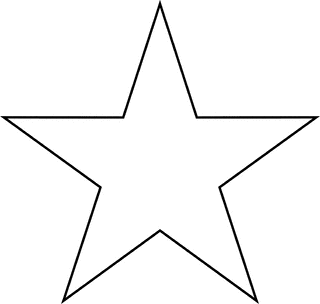Although I didn’t quite complete the Iconic You assignment in the more minimalist spirit it was perhaps supposed to reflect, I am still SO. DARN. PROUD. of the work I did here. This might actually be my favorite project from the whole semester. I’m SO HAPPY with the balance here, the way I was able to add a little texture to the piece, and how nicely the emboss effect emphasized the design of the stars.
Throughout the Riddle-Master Trilogy, the main protagonist, Morgon of Hed, is describe as having three blood-red stars across his brow. He was born with them, and they are the catalyst to his destiny.
And I swear to God, if anybody even MENTIONS Harry Potter I will flip tables, SO HELP ME.
I’ve actually put a LOT of thought into the way I visualize these stars. The idea of a “star” is pretty deeply encoded into our visual lexicon; most often, when someone writes the word “star,” the visual looks like some iteration of this:

The thing is, these stars are literally part of Morgon’s face. They’re not images or symbols, not really, they’re organic flesh and blood. I always thought they would be closer to scars or birthmarks than the perfect five-pointed design our culture has chosen to represent the concept of “star.” I started thinking about how scars look, how the skin pulls and stretches and puckers around them, and came up with the basic shape I used in the design above. They’re imperfect, and I always envisioned them as sort of recessed in his skin, as if the upper layer of his epidermis had been torn off somehow, exposing a thinner layer of skin beneath that clearly shows the color of his blood.
Yeah, so when I said “I put a lot of thought into this,” maybe I meant “I am mildly obsessed.”
The background color is also significant, though for a different reason. The first time I read through the Riddle-Master Trilogy I was pretty young, and didn’t have much knowledge about diversity in fantasy and scifi except the nagging suspicion that there was a rather marked dearth of brown people in all the books I was reading. A lot of really prominent fantasy, especially, written up until the mid to late 90′s doesn’t really address that, and just posits that since things are vaguely medieval in terms of setting, everybody is basically white. Sadly, McKillip’s work is no exception; although I don’t think any of those writers were consciously excluding people from their writing, it just wasn’t something anybody was trying to address. Either way, it’s buckets of problematic, and while re-reading this series again I decided I wanted to change that up a little bit.
Early in the books, Morgon’s little sister Tristan is described as a “thin, brown reed of a girl,” and from there I decided that in my head-canon, she and her siblings, as well as the rest of the people from their land, all have brown to light brown skin. This is borne out by various descriptions of Morgon and other people of Hed throughout the books. As a reflection of that, I made the background to the stars an approximation of Morgon’s skin color, though lightened a bit so the stars would stand out (the scuffed-up details in the background are just to add a bit of texture). In contrast to my minimalist poster, Morgon’s lover Raederle is what we’d consider white; again, that’s borne out by descriptions throughout the book, so I figure that most people in the Three Portions, where Raederle and her family are from, have pale skin.
Did I say “mildly obsessed”? Let’s just go with “I have basically been living this story for a month and I can taste it when I breathe,” and leave it at that.







